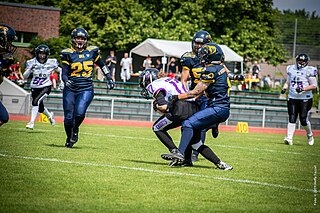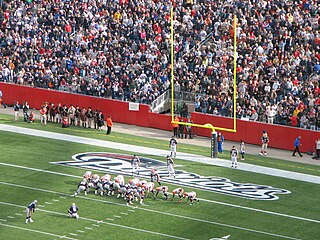
Canadian football is a sport played in Canada in which two teams of 12 players each compete for territorial control of a field of play 110 yards (101 m) long and 65 yards (59 m) wide attempting to advance a pointed oval-shaped ball into the opposing team's scoring area.
In gridiron football, not all players on offense are entitled to receive a forward pass: only an eligible pass receiver may legally catch a forward pass, and only an eligible receiver may advance beyond the neutral zone if a forward pass crosses into the neutral zone. If the pass is received by a non-eligible receiver, it is "illegal touching". If an ineligible receiver is beyond the neutral zone when a forward pass crossing the neutral zone is thrown, a foul of "ineligible receiver downfield" is called. Each league has slightly different rules regarding who is considered an eligible receiver.

In gridiron football, an onside kick is a kickoff deliberately kicked short in an attempt by the kicking team to regain possession of the ball. This is in contrast with a typical kickoff, in which the kicking team kicks the ball far downfield in order to maximize the distance the receiving team has to advance the ball in order to score. The risk to the team attempting an onside kick is that if it is unsuccessful the receiving team gets the ball and usually has a much better field position than with a normal kickoff.
In American football, a touchback is a ruling which is made and signaled by an official when the ball becomes dead on or behind a team's own goal line and the opposing team gave the ball the momentum, or impetus, to travel over or across the goal line but did not have possession of the ball when it became dead. Since the 2018 season, touchbacks have also been awarded in college football on kickoffs that end in a fair catch by the receiving team between its own 25-yard line and goal line. Such impetus may be imparted by a kick, pass, fumble, or in certain instances by batting the ball. A touchback is not a play, but a result of events that may occur during a play. A touchback is the opposite of a safety with regard to impetus since a safety is scored when the ball becomes dead in a team's end zone after that team — the team whose end zone it is — caused the ball to cross the goal line.
This is a glossary of terms used in Canadian football. The Glossary of American football article also covers many terms that are also used in the Canadian version of the game.
- Legally positioned at the kick-off or the snap. On kick-offs, members of the kicking team must be behind the kick-off line; members of the receiving team must be at least 10 yards from the kick-off line. On scrimmages, at the snap the offence must be behind the line of scrimmage; the defence must be at least one yard beyond the line of scrimmage.
- A player of the kicking team who can legally recover the kick. The kicker and any teammates behind the ball at the time of the kick are onside. Thus on kick-offs all players of the kicking team are onside, but on other kicks usually only the kicker is. The holder on a place kick is not considered onside.
- A defensive position on scrimmages, also called free safety. Typical formations include a single safety, whose main duty is to cover wide receivers. See also defensive back.
- A two-point score. The defence scores a safety when the offence carries or passes the ball into its own goal area and then fails to run, pass, or kick the ball back into the field of play; when this term is used in this sense, it is also referred to as a safety touch.

American and Canadian football are gridiron codes of football that are very similar; both have their origins in rugby football, but some key differences exist between the two codes.

In Canadian football, a single is a one-point score that is awarded for certain plays that involve the ball being kicked into the end zone and not returned from it.
Strategy forms a major part of American football. Both teams plan many aspects of their plays (offense) and response to plays (defense), such as what formations they take, who they put on the field, and the roles and instructions each player are given. Throughout a game, each team adapts to the other's apparent strengths and weaknesses, trying various approaches to outmaneuver or overpower their opponent in order to win the game.

Gameplay in American football consists of a series of downs, individual plays of short duration, outside of which the ball is dead or not in play. These can be plays from scrimmage – passes, runs, punts, or field goal attempts – or free kicks such as kickoffs and fair catch kicks. Substitutions can be made between downs, which allows for a great deal of specialization as coaches choose the players best suited for each particular situation. During a play, each team should have no more than 11 players on the field, and each of them has specific tasks assigned for that specific play.

A kickoff is a method of starting a drive in gridiron football. Additionally, it may refer to a kickoff time, the scheduled time of the first kickoff of a game. Typically, a kickoff consists of one team – the "kicking team" – kicking the ball to the opposing team – the "receiving team". The receiving team is then entitled to return the ball, i.e., attempt to advance it towards the kicking team's end zone, until the player with the ball is tackled by the kicking team, goes out of bounds, scores a touchdown, or the play is otherwise ruled dead. Kickoffs take place at the start of each half of play, the beginning of overtime in some overtime formats, and after scoring plays.

In gridiron football, the holder is the player who receives the snap from the long snapper during field goal or extra point attempts made by the placekicker. The holder is set on one knee seven yards behind the line-of-scrimmage. Before the play begins, he places the hand which is closest to the placekicker on the ground in a location designated by the kicker's foot, with his forward hand ready to receive the snap. After receiving the snap, the holder will place the football on the turf, or block, ideally with the laces facing the uprights and the ball accurately placed where the backhand was initially, then balancing the ball with one or two fingers until the ball is kicked.

High school football is gridiron football played by high school teams in the United States and Canada. It ranks among the most popular interscholastic sports in both countries, but its popularity is declining, partly due to risk of injury, particularly concussions. According to The Washington Post, between 2009 and 2019, participation in high school football declined by 9.1%. It is the basic level or step of tackle football.

A field goal (FG) is a means of scoring in gridiron football. To score a field goal, the team in possession of the ball must place kick, or drop kick, the ball through the goal, i.e., between the uprights and over the crossbar. The entire ball must pass through the vertical plane of the goal, which is the area above the crossbar and between the uprights or, if above the uprights, between their outside edges. American football requires that a field goal must only come during a play from scrimmage while Canadian football retains open field kicks and thus field goals may be scored at any time from anywhere on the field and by any player. The vast majority of field goals, in both codes, are place kicked. Drop kicked field goals were common in the early days of gridiron football but are almost never done in modern times. In most leagues, a successful field goal awards three points.
The following terms are used in American football, both conventional and indoor. Some of these terms are also in use in Canadian football; for a list of terms unique to that code, see Glossary of Canadian football.

American football, also known as gridiron, is a team sport played by two teams of eleven players on a rectangular field with goalposts at each end. The offense, the team with possession of the oval-shaped football, attempts to advance down the field by running with the ball or passing it, while the defense, the team without possession of the ball, aims to stop the offense's advance and to take control of the ball for themselves. The offense must advance at least ten yards in four downs or plays; if they fail, they turn over the football to the defense, but if they succeed, they are given a new set of four downs to continue the drive. Points are scored primarily by advancing the ball into the opposing team's end zone for a touchdown or kicking the ball through the opponent's goalposts for a field goal. The team with the most points at the end of a game wins.

In gridiron football, a two-point conversion or two-point convert is a play a team attempts instead of kicking a one-point conversion immediately after it scores a touchdown. In a two-point conversion attempt, the team that just scored must run a play from scrimmage close to the opponent's goal line and advance the ball across the goal line in the same manner as if they were scoring a touchdown. If the team succeeds, it earns two additional points on top of the six points for the touchdown, for a total of eight points. If the team fails, no additional points are scored.
Field goal range is the part of the field in American football where there is a good chance that a field goal attempt will be successful.

In gridiron football, a punt is a kick performed by dropping the ball from the hands and then kicking the ball before it hits the ground. The most common use of this tactic is to punt the ball downfield to the opposing team, usually on the final down, with the hope of giving the receiving team a field position that is more advantageous to the kicking team when possession changes. The result of a typical punt, barring any penalties or extraordinary circumstances, is a first down for the receiving team. A punt is not to be confused with a drop kick, a kick after the ball hits the ground, now rare in both American and Canadian football.

The conversion, try, or convert occurs immediately after a touchdown during which the scoring team is allowed to attempt to score one extra point by kicking the ball through the uprights in the manner of a field goal, or two points by bringing the ball into the end zone in the manner of a touchdown.












